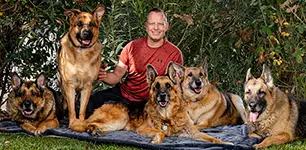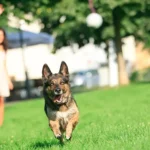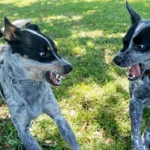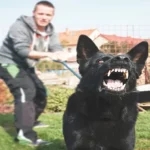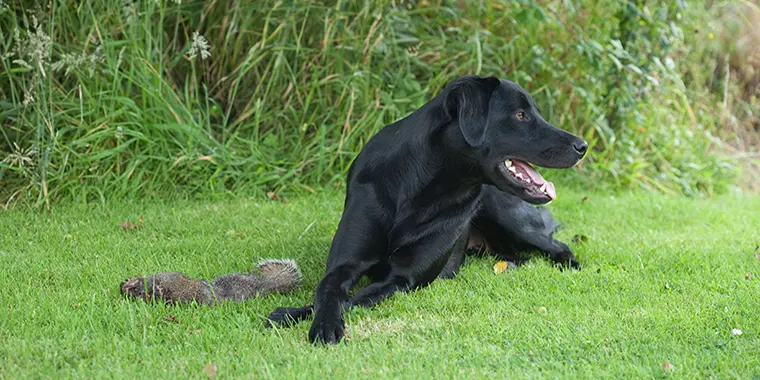
“My dog killed a squirrel. Is this aggression?” A good number of client calls each year start with a question along those lines. You could replace squirrel with bird, rat, gopher, lizard; you name it. Many of us live so far removed from nature that we have completely forgotten how life works. The idea that the family dog is a killer is a shock to many.
But dogs are apex predators. That means they sit on top of the food chain and don’t have natural enemies for whom they are a primary food source. Dogs are the hunters, not the hunted. As such, it is normal for a dog to chase and kill smaller animals. That doesn’t mean your dog is aggressive and will proceed to murder you or your children in your sleep. You are family. The squirrel is prey. It is also irrelevant if your dog is hungry when the squirrel comes along. Your dog didn’t chase the squirrel because you didn’t feed him enough breakfast. Dogs chase squirrels because they are fun to chase.
Dogs enjoy things that assure their survival, and domestication didn’t change that. All the things dogs enjoy are part of the predatory hunting sequence: searching, stalking, chasing, fighting, celebration, and consumption. If you want to explore this in more detail, I recommend our article Play is the Way! and the online presentation: Tug: A Deeper Perspective by Jay Jack from Next Level Dogs.
What Do You Do?
Tell your dog he is a good boy. Tell her she’s a good girl. Pet them and give them a treat. They did their job. Have you ever tried catching a squirrel? That is hard work! Let them know you appreciate their work effort. Sounds weird? It shouldn’t! This is the nature of your dog. Domestication didn’t change that.
The question behind the question is: Is my dog dangerous to my family? Is my dog aggressive? Maybe. Maybe not. The answer depends entirely on your dog but is unrelated to killing a squirrel. Killing other animals is what your dog was born to do. Appreciate their nature. There is no reason to fear it.
Actual aggression is something entirely different. People often call aggressive behaviors rooted in fear, aggression—including growling, showing teeth, and so on. However, none of those dominant behaviors are actual aggression.
What is Aggression?
Aggression is the intent to cause injury. But that doesn’t mean every injury caused by a dog is due to aggression. A dog that bites when it is scared is trying to create space, not injury—the injuries are accidental. Such a dog is not truly aggressive. It simply uses aggressive behaviors to create space. But, of course, that can be very dangerous. Some people—including many dog trainers—argue that this is a distinction without a difference. However, the reason for an action is extremely relevant.
We draw that distinction for ourselves in the legal system. There is no reason to view this differently with a dog. A super-friendly dog with poor bite control—the lack of ability to control how hard they bite—can also be very dangerous and may need to be muzzled in certain situations. That also is not aggression. True aggression includes the intent to cause injury. Anything short of that is something other.
Aggression is a behavior, not a personality trait. When we call a dog aggressive, we often mean the dog is prone to use aggressive behaviors. But, we are not our actions. Aggression is not what dogs are; it is what they sometimes do. Further, we can teach dogs to be more aggressive or less aggressive through our interactions with them.
The Ethology of Aggression
Ethologically, aggression is the result of a failed negotiation. Dogs negotiate through threats of violence and escalation of force using dominant and submissive behaviors. Only after that negotiation fails to resolve the dispute will it escalate to aggression. Also, it only gets to this point if the resource in dispute is worth dying for. This is often not the case. Predators have many reasons to avoid fighting with other predators. There is a significant risk of injury even for the stronger animal.
Aggression is usually not genetically driven, either. Tolerance for frustration is genetically driven. Genetics determine how quickly a dog becomes frustrated and how the dog reacts to that frustration. All aggression starts with frustration. That is what activates the RAGE system in the brain. We can affect dogs’ behaviors by helping them manage their frustration and teaching them how to handle conflict. However, some dogs love conflict, and the desire for conflict is a personality trait. A dog that doesn’t know how to engage in appropriate conflict will become aggressive under the right circumstances. While we can’t take away the desire for conflict, we can often direct it in a way that avoids more aggression.
Having explained the ethology behind aggression, it is still important to realize that some dogs are wired wrong and act aggressively when it is not in their best interest. But none of this is related to chasing and killing a squirrel.
What is Reactivity?
In contrast, reactivity is a visceral response without intent. The dog doesn’t know what else to do in a given situation. As such, reducing reactivity is about changing reactive (automatic) responses into reflective (deliberate) responses—teaching a dog to make better choices.
Leashes are a prime example of this. There is no such thing as “leash aggression.” Leashes don’t make dogs aggressive. That’s a common myth. However, restraining a dog will frustrate it, and that frustration can result in aggressive behaviors. In the case of a leash, simply teaching the dog to have a better relationship with the leash will reduce the frustration and, in return, remove the reactivity.
Side Note: Reactivity is a term dog many trainers use for inappropriate—usually aggressive—behaviors. Ethologists often hate the word because it doesn’t make much sense when you think about it. If a being doesn’t react to things, it will be dead. Reacting is responding in some way, and as long as you’re breathing, that is what we all do.
True Aggression is Rare
Of course, a dog could bite you under the right circumstances. However, it’s only a bite if it breaks the skin. A puncture is a bite; a scratch or nip isn’t. Dogs have a sophisticated set of weaponry in their mouths. Their use has been refined over thousands of years. If a dog puts its teeth on you and you don’t sustain an injury, you didn’t get lucky that you avoided injury. You were lucky that your dog didn’t mean to injure you. You are unharmed because your dog chose not to injure you. Of course, accidents can happen. If you play tug with your dog and get nipped by a tooth during play, that is an accident and not intentional. Like we can accidentally bump into someone by mistake, dogs can accidentally scratch or nip you, especially during high-arousal activities.
What About Dog Fights?
Dogs may engage in a scuffle to shut a barking dog up, put it in its place, or punish it for its behavior. Those are their goals. There is no intent to cause injury in those scenarios, although injury or death is possible regardless. For an altercation between dogs to be a fight, at least one participant must have the intent to cause injury.
Fights amongst dogs are rare because, in the canine world, fighting is evolutionarily undesirable for survival. Because of the dog’s teeth and claws, serious injuries are likely in a fight, and even the victor can still die of the injuries an hour later or be too weak to protect itself from an even weaker competitor. Fights exert energy, and injuries can lead to death. For this reason, dogs are naturally very good at conflict resolution and avoidance. It’s in their best interest to avoid fights.
Dominance is one of the strategies to avoid fights. Dominance is a ritualistic display to settle disputes over resources while avoiding fighting—fighting comes at a huge risk. Therefore, the term “dominance aggression” is technically incorrect. Dominance is a posturing behavior to avoid fighting. Dominance ends the moment a fight starts. Fighting is aggression in action.
Dominance behavior between dogs is only a problem if it is not responded to appropriately. If one party backs off during posturing, there will be no fight.
This article was also published on 4Knines.com.Play the Audio


